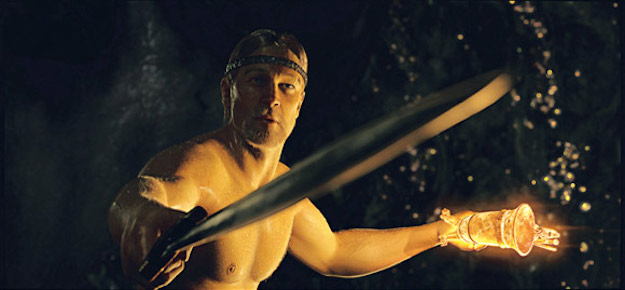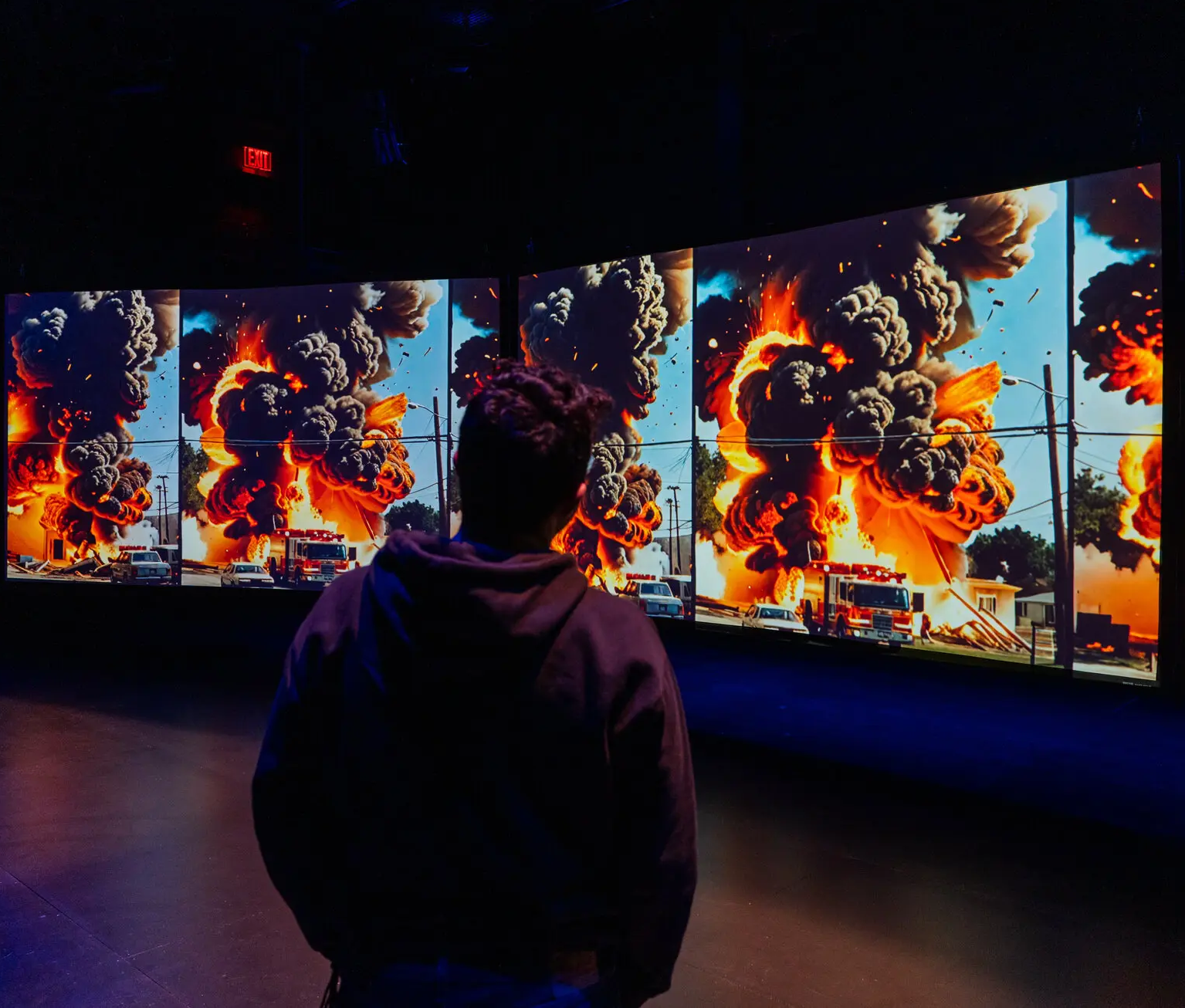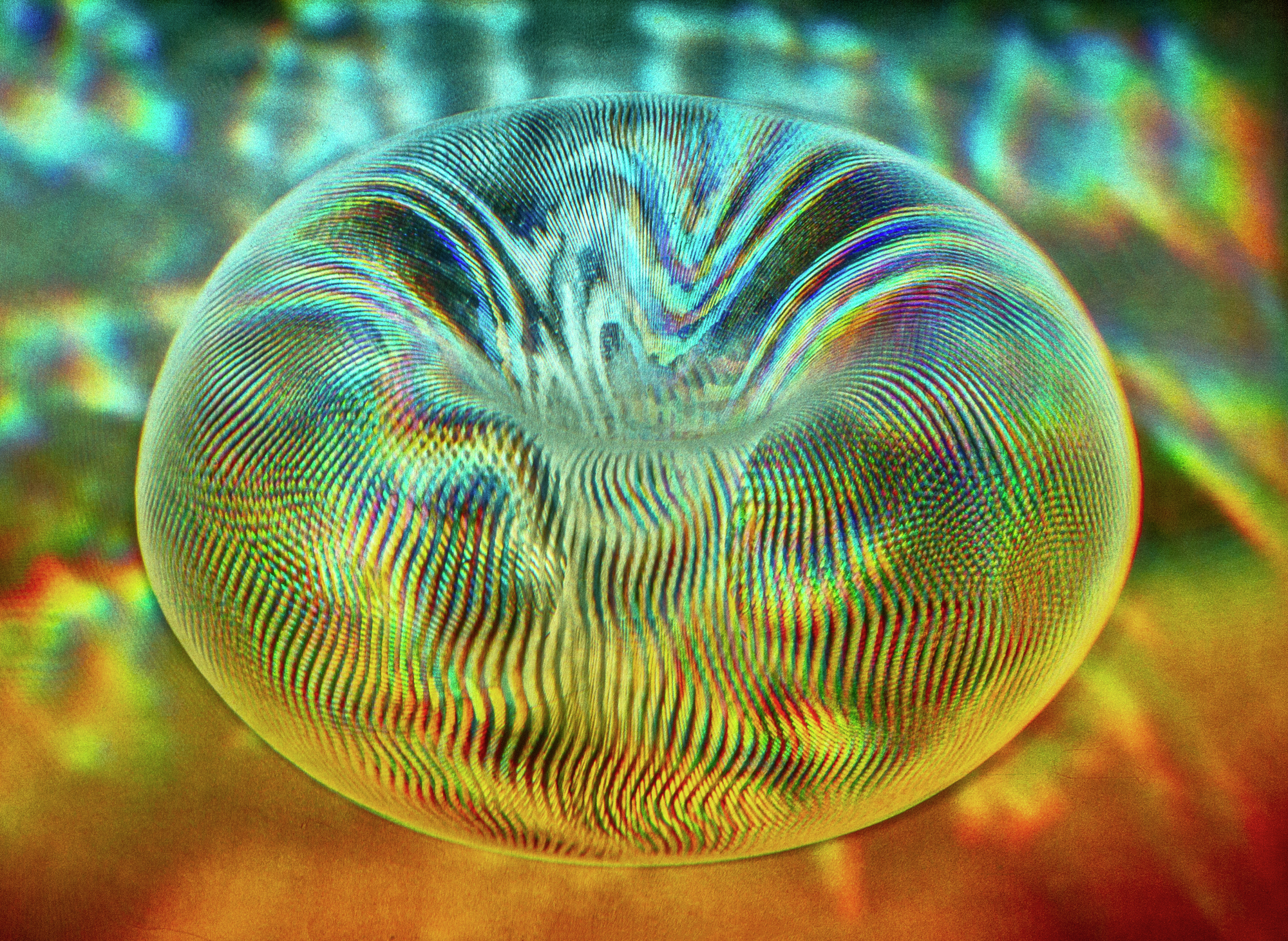
Ray Winstone as Beowulf
BEOWULF USED TO BE a Hollywood punch line, the cry agents uttered when confronted by arty screenwriters with an idea: “Oh God, just tell me it’s not Beowulf!” So it was a particular triumph when two such scribes, indie filmmaker Roger Avary and graphic novelist Neil Gaiman, took the stage at Comic-Con last summer to introduce Beowulf, Robert Zemeckis’s retelling of the primordial Anglo-Saxon monster epic — in 3-D. “It’s the oldest story in the English language,” Gaiman declared. “Told,” Avary interjected, “with the most modern technology available.”
Wearing special glasses that looked like Ray-Ban Wayfarers, the crowd of comic geeks sat rapt through scenes of menace and mayhem that rivaled anything in The Lord of the Rings. But the spine-tingling moments weren’t when Ray Winstone, playing Beowulf, thrusts his sword at the audience — a 3-D cliché from the ’50s. They came when he faces a digitally enhanced Angelina Jolie, playing the mother of the monstrous Grendel, in a dank, forbidding cave. Jolie makes for a stunningly seductive sorceress, so it’s all the more terrifying when her features momentarily morph into a death mask. A 3-D sword can make you jerk back in your seat, no question. But 3-D is even better when it draws you in — into the endless shadows of a cave, or into the vortex of a shrieking face.
Welcome to Hollywood |
How does the movie business work? Or (spoiler alert) does it work at all? |
The Blockbuster SyndromeWill Hollywood’s road to success be paved with ever-fewer, ever-more-expensive mega-movies?
|
Movies of the FutureGoodbye, passive viewing. Soon, every moviegoer will be a player.The New York Times | June 23, 2013 |
‘Avatar’: The CreationBuilding the world of ‘Avatar’ meant inventing effects you’ve never seen before.Wired 17.12 | December 2009 |
A Second Chance for 3-DTrilogies are done. CGI is ho-hum. Now Hollywood directors are tapping into the third dimension — starting with Angelina Jolie in ‘Beowulf.’
|
Close Encounters of the Worst KindThis time, E.T. wants to kill us. How Steven Spielberg reinvented ‘War of the Worlds’ in 72 days and learned to love digital filmmaking—fast.
|
The Second Coming of Philip K. DickHow a hyper-paranoid, pulp-fiction hack conquered the movie world 20 years after his death.
|
What Ever Happened to Michael Ovitz?Striving to make his comeback, CAA’s superagent is now an unemployment statistic. Seven lessons to be learned from the fall of the image king.
|
No Flowers, Send MoneyProducer Barry Navidi had it all—$13 million to play with and Marlon Brando, Debra Winger, Johnny Depp and John Hurt signed. Yet the picture folded two weeks into the shoot. What went wrong?Los Angeles Times | December 17, 1995 |
Twilight of the Last MogulLew Wasserman has been shaking Hollywood since the ’30s. When Seagram bought MCA, was he really out of the loop, or was he king of the dealmakers to the last?Los Angeles Times Magazine | May 21, 1995 |
The following day, the screenwriters were ecstatic. “It was like a third eye opened up in my forehead,” gushed Avary, who was already plotting out Beowulf when he wrote Pulp Fiction with Quentin Tarantino more than a decade ago. “It’s so large and extraordinary and hyperreal that I can’t be anything but giddy. When I left the theater, I wanted the rest of the world to look like that.”
Hollywood is betting that audiences will feel the same way. More than 50 years after its first run, 3-D is staging a comeback — this time in digital hi-def. Once a nausea-inducing fad, it’s now touted as the biggest gun yet in Hollywood’s ever-growing arsenal of f/x. When Beowulf comes out in November, it will premiere on nearly 1,000 3-D screens — the most ever. (A standard performance-capture version — think motion-capture but better — that’s not 3-D will be released simultaneously.) And nearly every major studio has a 3-D project slated for release in the next few years. DreamWorks Animation CEO Jeffrey Katzenberg has even announced that every release from his shop from 2009 on will be in 3-D. “It’s a bigger quantum leap than talkies,” declares Fox cochair Jim Gianopulos. “Talkies were an evolution of the medium. This is a complete transformation of the medium.”
A half-century ago, when Hollywood first pinned its hopes on the third dimension, studio chiefs were desperate to win audiences back from television. So they tricked out a run of B pictures — Bwana Devil, It Came from Outer Space, Vincent Price’s House of Wax — with what was then the latest gimmick. It worked for a while, but the novelty faded because the herky-jerky analog technology sent audiences home with throbbing heads and queasy stomachs.
Now Hollywood is once again up against new media — videogames, the Internet, home theater systems — and struggling to dazzle a moviegoing public accustomed to multimillion-dollar computer-generated effects. This time around, a handful of blockbuster directors are driving the action: Steven Spielberg, Peter Jackson, Robert Zemeckis, and James Cameron. “They’re all feeding off each other,” says Steve Starkey, Zemeckis’s longtime producing partner. “Jim dreams in 3-D, but they’re all pushing for it.”
Almost a decade ago, Cameron, flush with profits from Titanic and bored with conventional moviemaking, began developing a stereoscopic camera system he would later use to shoot undersea documentaries for Imax. Then, when Zemeckis was making an Imax 3-D version of The Polar Express, Jackson stopped by his facility in Santa Barbara and was wowed by what he saw. Zemeckis’s friend Spielberg soon became a convert, too. Now Spielberg and Jackson are planning a 3-D trilogy based on the Belgian comic series The Adventures of Tintin, Zemeckis is working on a 3-D performance-capture version of A Christmas Carol, and Cameron is deep in production on Avatar, a live-action 3-D sci-fi movie that he boasts will be Titanic in space.
For A-list directors like these, 3-D is a new tool for storytelling. Like light and sound, it can alter a mood or highlight a moment — once you learn how to use it. “It’s a new frontier,” Cameron declares. “Everybody’s doing it differently. Peter Jackson’s doing it his way, I’m doing it my way. There’s no right or wrong. Do you feel ill after a screening or do you feel pretty good? We now know how to achieve the latter.”
Audiences at a live-action 3-D movie are watching two images that have been shot with two cameras and then projected simultaneously. If it’s a performance-capture film, the original footage is run through software that splits the image in two for a 3-D effect. Polarized glasses enable moviegoers to see one image with one eye and the other image with the other. In the past, if those images were shot or projected even slightly out of synch — as often happens with analog 3-D setups — the brain would get disoriented. With digital 3-D, however, a rig housing two separate, synchronized cameras shoots “in stereo” and a digital projector displays the results. The result is sharp, eye-popping images without the 3-D hangover.
The technology is cool, but for 3-D movies to be blockbusters, studios need to be able to show them on thousands of screens across the country. Which means theaters have to switch to digital projection systems, an overhaul they have long resisted. That’s now changing. After years of arguing over expense, studios have agreed to shoulder a portion of the cost to convert theaters to digital, and the prospect of a big box-office take for 3-D films gives multiplex owners the motivation to pick up the rest of the tab. “Once theater owners realize there are enough huge filmmakers releasing 3-D content,” says Starkey, “digital cinema will expand, and 3-D will be everywhere.”

 November 1, 2007
November 1, 2007





